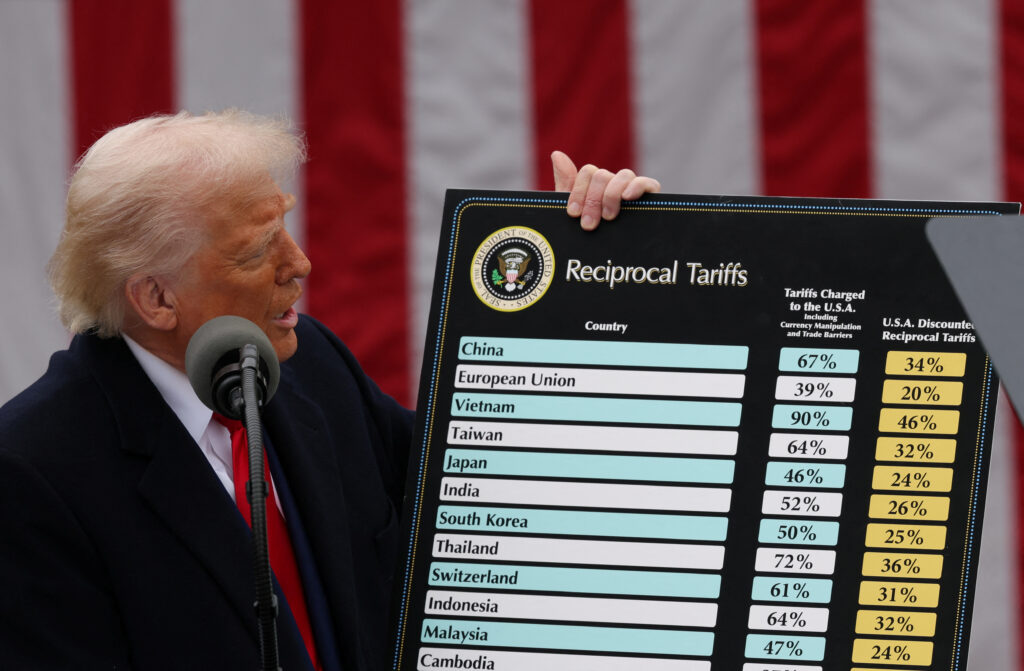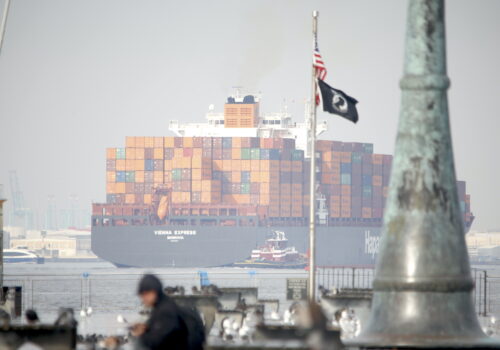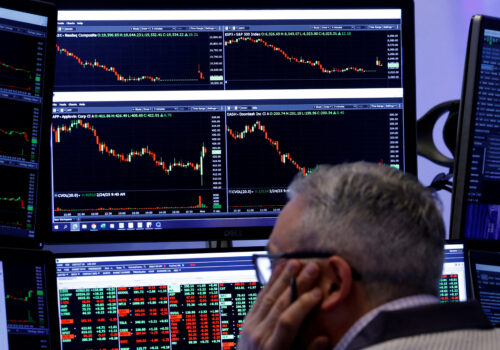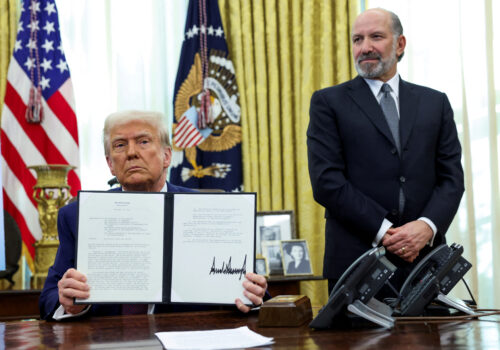JUST IN
“It’s our declaration of economic independence.” That’s how President Donald Trump described Wednesday’s Rose Garden announcement that the United States will levy 10 percent baseline tariffs on all imported goods. Trump also announced “reciprocal tariffs” on dozens of other countries, including steep rates on major trading partners such as China (54 percent in total), the European Union (20 percent), and Japan (24 percent), though Canada and Mexico were spared from new tariffs. How will these tariffs upend US trade partnerships, international financial markets, and the global economy? And how might the countries hit the hardest retaliate? Our experts at the GeoEconomics Center, which is following each move in its Trump Tariff Tracker, declare their independent assessments below.
TODAY’S EXPERT REACTION BROUGHT TO YOU BY
- Josh Lipsky (@joshualipsky): Senior director of the Atlantic Council’s GeoEconomics Center and former adviser to the International Monetary Fund
- L. Daniel Mullaney: Nonresident senior fellow with the Europe Center and GeoEconomics Center, and former assistant US trade representative
- Barbara C. Matthews: Nonresident senior fellow at the GeoEconomics Center and former US Treasury attaché to the European Union
Zooming out
- The historic significance of Wednesday’s actions are clear, Josh tells us: “The United States said the global trading system we helped create no longer works for us.” He notes that these new levies, scheduled to go into effect next week, would raise overall US tariff rates to north of 20 percent—their highest level in a century, exceeding even the Smoot-Hawley era of the 1930s.
- Trump’s tariff announcements underscored that he “sees the world less in terms of allies and adversaries than in terms of countries that run trade deficits with the US versus countries that run trade surpluses,” Josh says.
- Josh points out that Japan will be tariffed at a much higher rate than Iran. “These decisions are not based on systems of government or military alliances or historical relationships. They are based on a new formula—where trade is the organizing principle behind Trump’s engagement with the world.”
Sign up to receive rapid insight in your inbox from Atlantic Council experts on global events as they unfold.
Zooming in
- The difference in rate assigned to each country “suggests that the tariffs are actually motivated by perceived imbalances in trade relationships” rather than a simple desire to “erect a tariff wall around the United States,” says Dan. For example, he notes that the European Union, which has a $200 billion goods trade deficit with the United States, was tariffed much more than the United Kingdom, which has none.
- An additional executive order closing tariff exemptions for low-value goods from China underscores the national security concerns motivating the tariffs, Barbara tells us. She notes that the administration justified the move “on the grounds that those low-value imports facilitate the fentanyl trade.”
- The especially high tariffs on China are a major reason for the negative overnight market reaction to the announcements, says Josh, as 54 percent is “above and beyond” what Beijing can manage through currency maneuvers. Potential alternative Southeast Asian trading partners such as Vietnam were hit hard as well. “From your Airpods to your Air Jordans, hundreds of products Americans use in day-to-day life are set to get more expensive.”
Response time
- Dan has some advice for European leaders as they deliberate how to respond: “It is unhelpful to castigate the United States for imposing tariffs” and then vow to “strike back” on politically sensitive targets such as Kentucky bourbon and Florida orange juice. He argues that “a more constructive” reaction would be to “rebalance” transatlantic trade obligations by taking an approach similar to a World Trade Organization dispute and withdrawing equivalent concessions with respect to the United States.
- At the same time, Dan adds, European officials should work with the Trump administration to reach accommodations in lieu of tariffs. This could include, for instance, renewing “work on a steel and aluminum arrangement,” cooperating on nonmarket economy policies and practices, and reducing regulatory trade barriers. “We’re in an unprecedented and disruptive era, but there are avenues for restoring balance and building up the transatlantic trade relationship.”
- While countries may opt to impose retaliatory tariffs on the United States, Barbara notes that tariff rates are only part of the picture. “No one wins a trade war,” she cautions, adding that “negotiations based merely on tariff levels will not be sufficient” to address the Trump administration’s other economic and security concerns, such as value-added taxes, currency manipulation, and drug trafficking. Instead, she says, talks with Washington must address “a broad range of security and geoeconomic issues beyond trade policy that the United States has been raising for a number of years.”
- All of these tariff announcements remain subject to change based on negotiations. “Markets need to be ready for a steady stream of policy volatility and adjustments,” says Barbara, “as the terms of trade shift to reflect a new geopolitical balance of power as defined by the United States.”
Further reading
Tue, Feb 4, 2025
Where do the Trump tariffs go from here?
Fast Thinking By
US tariffs on China went into effect today, while President Donald Trump paused levies on Mexico and Canada. Our experts explain who and what could be next.
Tue, Mar 4, 2025
A Wall Street wake-up call on Trump’s tariffs
Fast Thinking By
As markets fall in response to the US decision to increase the cost of importing goods from Canada, Mexico, and China, how is the US president thinking about tariffs?
Thu, Feb 13, 2025
Experts react: What does Trump’s reciprocal tariff announcement mean for global trade?
New Atlanticist By
Our trade experts explain how the Trump administration's plans for reciprocal tariffs could play out.
Image: US President Donald Trump delivers remarks on tariffs in the Rose Garden at the White House in Washington, DC, US, April 2, 2025. REUTERS/Carlos Barria.




